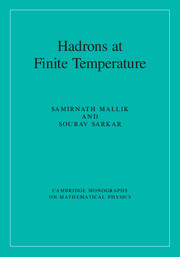Book contents
- Frontmatter
- Dedication
- Contents
- Preface
- Notation
- 1 Free Fields in Vacuum
- 2 Spontaneous Symmetry Breaking
- 3 Chiral Perturbation Theory
- 4 Thermal Propagators
- 5 Thermal Perturbation Theory
- 6 Thermal Parameters
- 7 Two-Loop Results
- 8 Heavy Ion Collisions
- 9 Non-Equilibrium Processes
- Appendix A General Fields
- Appendix B Global Symmetries
- Appendix C Exponential Operator
- Appendix D Propagator at Origin of Coordinates
- Appendix E Reaction Rates in Vacuum and Medium
- Appendix F Coupling Constants
- Appendix G Imaginary Time Method
- Appendix H Quark Condensate from Partition Function
- Appendix I Quark Condensate from Density Expansion
- Index
- References
6 - Thermal Parameters
Published online by Cambridge University Press: 27 October 2016
- Frontmatter
- Dedication
- Contents
- Preface
- Notation
- 1 Free Fields in Vacuum
- 2 Spontaneous Symmetry Breaking
- 3 Chiral Perturbation Theory
- 4 Thermal Propagators
- 5 Thermal Perturbation Theory
- 6 Thermal Parameters
- 7 Two-Loop Results
- 8 Heavy Ion Collisions
- 9 Non-Equilibrium Processes
- Appendix A General Fields
- Appendix B Global Symmetries
- Appendix C Exponential Operator
- Appendix D Propagator at Origin of Coordinates
- Appendix E Reaction Rates in Vacuum and Medium
- Appendix F Coupling Constants
- Appendix G Imaginary Time Method
- Appendix H Quark Condensate from Partition Function
- Appendix I Quark Condensate from Density Expansion
- Index
- References
Summary
We are now in a position to apply chiral perturbation theory to find the changes in hadronic parameters at non-zero temperature and density. This topic was initiated by Leutwyler and collaborators, who calculated in this theory the thermal properties of pion gas, including the quark condensate and parameters of hadrons like the pion and nucleon [1–4]. This chapter and the next one review some of their works. We also describe results for other hadrons and consider the medium consisting of (infinite) nuclear matter.
Earlier in Sections 3.10 to 3.13 we used the method of external fields to evaluate the one- and two-point functions of densities and currents in vacuum. As an example of one-point functions, we found the renormalised quark condensate. The two-point functions were obtained in the neighbourhood of poles of particles communicating with the currents. The pole positions and residues gave the renormalised hadronic couplings and masses of particles. Essentially the same method can be applied to find how such parameters depend on temperature and chemical potential. Instead of their vacuum expectation values, we now have to work with the ensemble averages. The same vertices and graphs appear in the evaluation, but with vacuum propagators replaced by thermal ones, a procedure that we explained in detail in the last chapter. The additional pieces in thermal propagators give rise to temperature and chemical potential dependence of the parameters. In this chapter we describe results to one loop, extending some of these to two loops in the next chapter.
As mentioned earlier, describing a particle in medium involves the four-velocity of the medium, in addition to its four-momentum. Because we work with the medium at rest, we do not expect relativistic covariance in calculations [5]. In this chapter the one-loop calculations, however, do not show up this non-covariance, except for pion parameters in nuclear matter, leading to two pion decay constants [6]. In the next chapter the two-loop calculation of pion parameters in pion medium will show this behaviour [7]. This situation is also known to arise in non-relativistic systems [8].
- Type
- Chapter
- Information
- Hadrons at Finite Temperature , pp. 137 - 153Publisher: Cambridge University PressPrint publication year: 2016



